

Joel Berman's Blog - Planning a game â finding your way. The following blog post, unless otherwise noted, was written by a member of Gamasutra’s community.
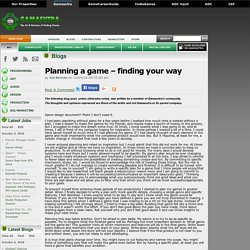
The thoughts and opinions expressed are those of the writer and not Gamasutra or its parent company. Game design document? Pssht I don't need it. I had been operating without plans for a few years before I realised how much time is wasted without a plan. I had a dream to make fun games for my friends, and maybe make a bunch of money in the process, but I struggled to make this dream come true. I never enjoyed planning and relied on inspiration but I must admit that this did not work for me. To prevent myself from entering these periods of low productivity I started to plan my games in greater detail.
Planning this way takes practice. Aric’s World. Death of the game design document. Jagex's James Sweatman on why central design documents don't always work, and the alternatives available It has been called many things over the years – GDD, Design Bible, Game Overview Document.

Regardless of title, they all describe one thing; the living design document for a video game. The GDD has been a pillar of design direction for decades, providing countless developers and artists a singular vision for a game. Sounds great right? Who wouldn't want one place to store everything there is to know about a game? I wouldn't. I joined the game industry in 2008, fresh out of university and with big dreams. To start with I was right: Our design team worked closely with EA, who at the time wanted rigid design documentation, with briefs upon briefs and documents on documents. The old ways I'd held so dear and believed in so much had started to crumble away. So why don't GDDs work? OnePageDesigns-GC-2011. Tiny Game Design Tool. Features - Design Document: Play With Fire. [In the spirit of community, and for the sake of education, International Hobo's Chris Bateman has provided a rare public look at an in-depth commercial game design document.
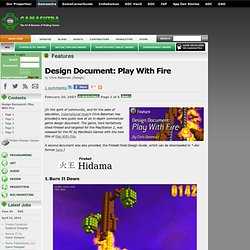
The game, here tentatively titled Fireball and targeted for the PlayStation 2, was released for the PC by Manifesto Games with the new title of Play With Fire. A second document was also provided, the Fireball Field Design Guide, which can be downloaded in *.doc format here.] Fireball Hidama Example level from Play With Fire 1.1. Jason Bakker's Blog - A GDD Template for the Indie Developer. The following blog post, unless otherwise noted, was written by a member of Gamasutra’s community.
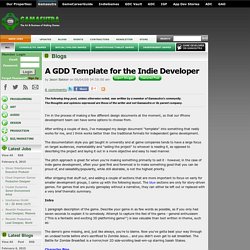
The thoughts and opinions expressed are those of the writer and not Gamasutra or its parent company. I'm in the process of making a few different design documents at the moment, so that our iPhone development team can have some options to choose from. After writing a couple of docs, I've massaged my design document "template" into something that really works for me, and I think works better than the traditional formats for independent game development. The documentation style you get taught in university and at game companies tends to have a large focus on target audiences, marketability and "selling the project" to whoever is reading it, as opposed to describing the project and laying it out in a more objective and easy to read manner. Intro 1 paragraph description of the game. The dame's gone missing, and, just like always, you're to blame.
Character Bios. 5 Alternatives to a Game Design Doc « Gravity Ghost. If you're building a game with a team, communicating the design vision in a clear manner is essential.
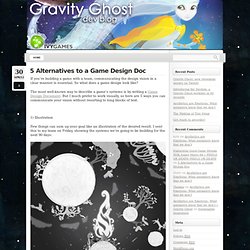
So what does a game design look like? The most well-known way to describe a game's systems is by writing a Game Design Document. But I much prefer to work visually, so here are 5 ways you can communicate your vision without resorting to long blocks of text. Few things can sum up your goal like an illustration of the desired result. I sent this to my team on Friday, showing the systems we're going to be building for the next 90 days: Pencil sketch, plus a Photoshop pass for color and contrast.
Even if you've embraced the philosophy of rapid prototyping and iteration, at each stage you need a goal to iterate towards. What if your game needs moving parts to explain what's going on? The final presentation had nearly 70 slides illustrating steps in the gameplay. The Two C. Introduction There have been a countless number of books and articles written about the games industry from both its technical and theoretical aspects.

However many of these have been written by people who although deserving of respect due to the amount of effort they have used to achieve their professional status are still probably not the ideal people to listen to. The reason for this is as follows: To make video games you only really need the technical knowledge to do so. However to create good games requires both a sound technical knowledge and creative and communication skills. Unfortunately there are many people in the industry without these skills. This article therefore has been written with a focus on creative and communication skills, not technical. Creativity Anybody can be creative. Another complaint is that there are too many licensed games. Efficient writing for video games. Good writing in video games is crucial.
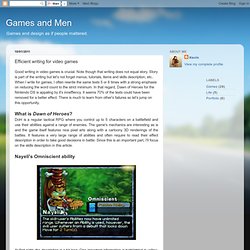
Note though that writing does not equal story. Story is part of the writing but let's not forget menus, tutorials, items and skills description, etc.. When I write for games, I often rewrite the same texts 5 or 6 times with a strong emphasis on reducing the word count to the strict minimum. In that regard, Dawn of Heroes for the Nintendo DS is appaling by it's inneffiency. Game Design Logs. If you still practice or encourage the outdated practice of writing long design documents, you are doing your team and your business a grave disfavor.
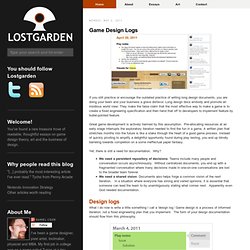
Long design docs embody and promote an insidious world view: They make the false claim that the most effective way to make a game is to create a fixed engineering specification and then hand that off to developers to implement feature by bullet-pointed feature. Great game development is actively harmed by this assumption. Pre-allocating resources at an early stage interrupts the exploratory iteration needed to find the fun in a game. A written plan that stretches months into the future is like a stake through the heart of a good game process. Instead of quickly pivoting to amplify a delightful opportunity found during play testing, you end up blindly barreling towards completion on a some ineffectual paper fantasy. Yet, there is still a need for documentation. Game design.
Hrehovcsik-M-2004-Game-Concept-and-Design-Document-Template.pdf. Tom Sloper's Format for Game Design Specifications. June 26, 1997.
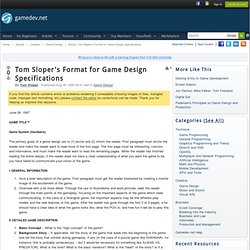
Url. GDC 2010: One-Page Designs. This talk by Stone LeBrande, Creative Director at EA/Maxis, was the single most inspiring session I attended on Thursday.
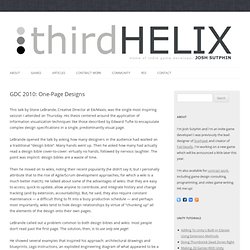
His thesis centered around the application of information visualization techniques like those described by Edward Tufte to encapsulate complex design specifications in a single, predominantly visual page. LeBrande opened the talk by asking how many designers in the audience had worked on a traditional “design bible”. Many hands went up. Then he asked how many had actually read a design bible cover-to-cover: virtually no hands, followed by nervous laughter. The point was implicit: design bibles are a waste of time.
Then he moved on to wikis, noting their recent popularity (he didn’t say it, but I personally attribute that to the rise of Agile/Scrum development approaches, for which a wiki is a much better match). LeBrande called out a problem common to both design bibles and wikis: most people don’t read past the first page. This talk was, for me, electrifying. Features - The Anatomy of a Design Document, Part 1: Documentation Guidelines for the Game Concept and Proposal. The Anatomy of a Design Document, Part 1: Documentation Guidelines for the Game Concept and Proposal The purpose of design documentation is to express the vision for the game, describe the contents, and present a plan for implementation.
A design document is a bible from which the producer preaches the goal, through which the designers champion their ideas, and from which the artists and programmers get their instructions and express their expertise. Unfortunately, design documents are sometimes ignored or fall short of their purpose, failing the producers, designers, artists, or programmers in one way or another. Clarity by Design » DarrellHardy.com. Sit down, son. It’s time we had a talk about where video games come from. Flark Design » Blog Archive » Stop Calling Them Design Docs - Knowing the game — by Mike Birkhead. (this is a reworking, and expansion of a comment on an earlier AltDev article.) And start calling them Design Tools. Docs get appended, while Tools are put aside as needs change. Design docs are necessary, but their definition is both antiquated and inadequate to the task they provide.
In fact, their task–as tools–is threefold, and it worries me that none of this was explained to me. A game designers job goes through three major periods: figuring out what the hell you are making, getting the team on board with the initial idea, and then managing the vision as the game is redesigned (like, a lot – a LOT a lot); similarly, your documentation, as the project goes through these stages, serves three purposes: extrapolation, communication, and collation. Extrapolation Filling the gaps in your big picture vision First comes the pitch document (or the bitch document as I like to call it, because it’s a bitch to write). Communication.